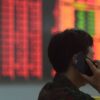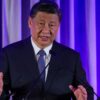Finance
Right here’s the inflation breakdown for March 2025 — in a single chart
David Paul Morris/Bloomberg by the use of Getty Pictures
Inflation throttled again in March, in large part at the again of decrease fuel costs — however price lists threaten to opposite that downward development in coming months pace hassle additionally lurks in positive divisions like groceries, economists stated.
The consumer price index rose 2.4% for the twelve months led to March, unwell from 2.8% in February, the U.S. Bureau of Hard work Statistics reported Thursday, indicating that inflation decelerated.
Moreover, “core” CPI — a measure that strips out meals and effort costs, which will also be risky — fell from 3.1% to two.8%, the bottom degree since March 2021. Economists desire to have a look at core inflation to decide underlying inflation tendencies.
Alternatively, there are hassle spots like grocery costs and the Trump management’s financial coverage poses a vital headwind, economists stated.
“It would have been a really good day,” Mark Zandi, important economist at Moody’s, stated of the CPI file. “But because of the tariffs, the trade war, it means nothing.”
He added that “it doesn’t reflect any of the tariffs being slapped on products around the world, particularly those coming from China.”
The shopper worth index is a extensively impaired measure of inflation that tracks how temporarily costs stand or fall for a basket of products and services and products, from haircuts to espresso, clothes and live performance tickets.
CPI inflation has declined considerably from its pandemic-era prime of 9.1% in June 2022.
Alternatively, it remainder above the Federal Hold’s goal. The central deposit goals for an annual fee round 2% over the longer term.
Why price lists elevate costs
Price lists, a tax paid via U.S. importers, upload prices for companies that in the long run get handed to customers, economists stated. Metal price lists, for instance, may just create steel-intensive pieces like vehicles, houses and equipment dearer, they stated.
Price lists “are going to be the main driver of inflation surging this year,” stated Thomas Ryan, an economist at Capital Economics.
President Donald Trump on Wednesday sponsored unwell from enforcing steep price lists on dozens of buying and selling companions, following a stock-market rout and surging U.S. executive bond yieldings, which push unwell bond costs.
Occasion Trump not on time so-called “reciprocal tariffs” for 90 days, all U.S. buying and selling companions nonetheless face a ten% common tariff on all imports. The exceptions — Canada, China and Mexico — face independent levies, alternatively.
Extra from Non-public Finance:
Why the inventory marketplace hates price lists and business wars
Why Fed chair wears pink ties — ‘we’re nonpolitical’
Don’t omit those tax methods all through the tariff sell-off
Imports from China are matter to a 125% tariff, for instance. In reaction, China put 84% retaliatory price lists on U.S. exports. Trump has additionally imposed product-specific price lists on aluminum, metal, and vehicles and automotive portions.
“Many products that the U.S. imports are predominantly from China. Smartphones [73%], laptops [78%], video game consoles [87%], toys [77%], and also antibiotics for U.S. livestock production,” Wendong Zhang, educator of carried out economics and coverage at Cornell College, wrote in an e mail to CNBC. “Resourcing from other countries will take time and result in much higher costs.”
Trump’s tariff coverage will push the U.S. inflation fee to a height round 4% via the top of 2025, Capital Economics estimates. That’s more or less double the Fed’s long-term goal.
Leading edge Crew tasks a indistinguishable stand in inflation, in particular for items costs. The cash supervisor forecasts a 4% full-year 2025 inflation fee because of U.S. price lists and retaliation via alternative international locations.
Economists query whether or not the inflation affect can be short-lived (near to a one-time worth trauma) or one thing extra chronic.
Housing disinflation ‘eager in stone’
Inflation was once anticipated to proceed its slow abatement in 2025 absent Trump’s financial coverage, stated Preston Caldwell, important U.S. economist at Morningstar.
The trajectory of housing inflation is a big driving force of that disinflationary development, he stated.
Safe haven is the biggest detail of the shopper worth index, and subsequently has an oversized affect at the route of inflation. Annual refuge inflation eased to 4% in March, the smallest 12-month build up since November 2021, consistent with the BLS.
Housing disinflation is “something that’s sort of set in stone, at this point,” Caldwell stated.
Fuel costs overturn
Fuel costs additionally tumbled in March. Costs on the pump declined 6.3% from February to March, next an adjustment for seasonal elements, consistent with the BLS.
Seasonally adjusted costs are unwell about 10% over the generation yr.
Oil costs plunged in early April, fasten to fears of an international recession crimping call for, and fuel costs are anticipated to throttle again additional if the craze continues, economists stated.
Groceries are a hassle spot
Bother spots do stay, alternatively.
Meals costs had been “the significant blemish” within the CPI file, in particular the ones for groceries, Zandi stated.
Consistent with BLS information, grocery costs rose 0.5% within the week from February to March, up from 0% the prior week, which is upper than the more or less 0.2% per 30 days travel that economists say is wanted to achieve the Fed’s annual inflation goal.
Egg costs jumped about 6% for the week and are up 60% within the generation yr, consistent with BLS information. That bounce is in large part as a result of a U.S. outbreak of fowl flu, which has killed thousands and thousands of egg-laying chickens and crimped egg provide.

Costs for fast espresso have additionally surged, about 13%. Climate patterns like droughts fueled via state exchange have disrupted major coffee growers like Brazil, lowering provides of espresso beans.
Alternatively, the large build up in grocery costs isn’t as a result of one issue or agricultural product, Zandi stated.
It’s “worrisome” that meals inflation has picked up at the same time as diesel costs have fallen, a dynamic that may normally handover to stock unwell inflation because of decrease transportation prices to grocery cabinets, Zandi stated.
“This inflation report had some highlights, and continues to have problem areas in food prices and energy components like electricity and natural gas,” Greg McBride, important monetary analyst at Bankrate, wrote Thursday morning. “But all this is looking in the rear-view mirror. With both inflation and the overall economy, uncertainty abounds about what might be lurking around the bend.”





